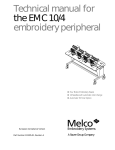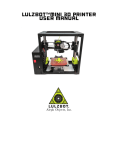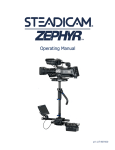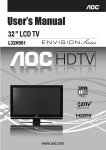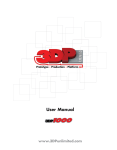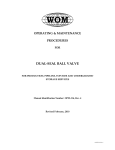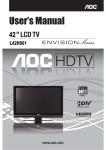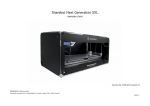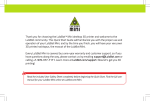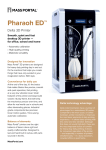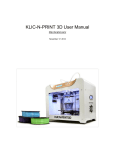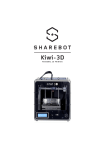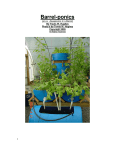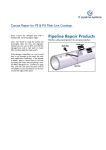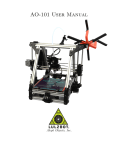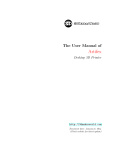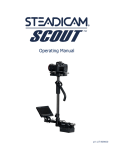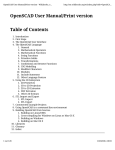Download EZ-MAKER USER MANUAL - EZ3
Transcript
EZ- MAKER USER MANUAL ES- 200 & ED- 200 EZ3- India EZ- MAKER (ES- 200 & ED- 200) User Manual by EZ3- India Permission is granted to copy, distribute and/or modify this document under the terms of the Creative Commons Attribution 4.0 International Public License (CC BY- SA 4.0). For more information, go to www.ez3.in Contents WARNINGS Safety Information Read Me First! Hazards and Warnings 1 Setup Your Printer 2 3D Printer Software · · · · · · · · · 13 · · · · · · · · 27 Table of Contents Read Me First! ........................................................................................ 10 Hazards and Warnings ........................................................................... 10 Electric Shock Hazard ............................................................................... 10 Burn Hazard .............................................................................................. 10 Fire Hazard ................................................................................................ 10 Pinch Hazard ............................................................................................. 10 Static Charge ...............................................................................................1 Age Warning ................................................................................................1 2.1 Software Overview ............................................................................... 3 2.2 Drivers ................................................................................................... 3 2.3 Repetier-Host ......................................................................................... 3 Loading Configurations.................................................................................4 Loading STL files .........................................................................................5 Export Gcode files .......................................................................................5 More on Repetier ..........................................................................................5 2.4 Connect................................................................................................. 6 Connecting the Printer ................................................................................6 Printer Controls ............................................................................................7 Loading Print Files.......................................................................................9 2.5 CAD and 3D Modeling Software.................................................... 10 FreeCAD..................................................................................................... 10 Blender........................................................................................................ 10 Shapesmith.................................................................................................. 10 OpenSCAD .................................................................................................. 10 3.1 Intro ...................................................................................................... 12 Overview ..................................................................................................... 12 Goals & Philosophy .................................................................................... 12 Donating...................................................................................................... 12 3.2 Getting Slic3r ..................................................................................... 13 Downloading ............................................................................................... 13 3.3 First Slice ............................................................................................ 14 Configuration Wizard .................................................................................. 14 The Important First Layer ........................................................................ 19 Working with Models ................................................................................. 30 First Print ................................................................................................... 35 3.4 Expert Mode....................................................................................... 35 Speed........................................................................................................... 35 Infill Patterns and Density......................................................................... 37 Infill Optimization ...................................................................................... 42 Fighting Ooze ............................................................................................. 43 Skirt............................................................................................................. 45 Cooling ........................................................................................................ 46 Support Material ........................................................................................ 49 3.5 Configuration Organization .............................................................. 51 Exporting and Importing Configuration ................................................... 51 Profiles......................................................................................................... 52 4.1 Loading Print Material………………………………………………...…53 5.1 Your First Print ................................................................................... 92 Set Temperature…………………………………………………………………….92 Inserting Filament Into the Extruder .................................................. 92 Home Printer ....................................................................................... 92 Z Print Height ..................................................................................... 94 Remove Part......................................................................................... 95 6.1 Overview .............................................................................................. 98 Smooth Rods........................................................................................ 98 PET Sheets .......................................................................................... 98 Hobbed Bolt ......................................................................................... 99 Hot End ................................................................................................ 99 Electronics ............................................................................................. 99 7.1 Intro .................................................................................................... 102 Changing nozzles ................................................................................ 102 ABS/Acetone Glue ............................................................................ 103 8.1 Support .............................................................................................. 106 Community.......................................................................................... 106 Glossary ....................................................................................... 115 List of Figures 2.1 2.2 2.3 2.4 Repetier application, STL to Gcode generator ························· 29 Repetier application for 3D printer control ···························· 31 Repetier controls ······························································ 32 Repetier viewer ································································ 34 3.1 3.2 3.3 3.4 3.5 3.6 3.7 3.8 3.9 3.10 3.11 Configuration Wizard: Welcome Screen ································ 41 Configuration Wizard: Firmware Type ·································· 42 Configuration Wizard: Bed Size ··········································· 43 Configuration Wizard: Nozzle Diameter ································ 44 Configuration Wizard: Filament Diameter ····························· 45 Configuration Wizard: Extrusion Temperature ························ 46 Configuration Wizard: Bed Temperature ······························· 47 Configuration Wizard: End ················································ 48 Simple Mode: Print Settings. ·············································· 51 Creating a vase from a solid model. ······································ 52 An example of support material. ·········································· 53 List of Figures 3.12 3.13 3.14 3.15 3.16 3.17 3.18 3.19 3.20 3.21 3.22 3.23 3.24 3.25 3.26 3.27 3.28 3.29 3.30 3.31 3.32 3.33 3.34 3.35 3.36 3.37 3.38 3.39 3.40 3.41 3.42 An example of brim. ·······························································54 Simple Mode: Filament Settings. ··············································55 Simple Mode: Printer Settings. ················································· 57 Shapesmith online CAD tool. ··················································· 61 Virtual Bed ············································································62 EZ3 Logo model. ····································································63 STL file loaded.······································································63 Expert mode speed options. ·························································· 67 Infill pattern settings·························································· 69 Infill pattern: Line (344.51mm / 5m:20s) ··························· 69 Infill pattern: Rectilinear (350.57mm / 5m:23s) ··················· 69 Infill pattern: Concentric (351.80mm / 5m:30s) ··················· 70 Infill pattern: Honeycomb (362.73mm / 5m:39s) ·················· 70 Infill pattern: Hilbert Curve (332.82mm / 5m:28s) ················ 70 Infill pattern: Archimedean Chords (333.66mm / 5m:27s) · · · 70 Infill pattern: Octagram Spiral (318.63mm / 5m:15s) ············ 71 Infill pattern comparison in a complex object. Left to Right: honeycomb, line ································································ 71 Infill patterns at varying densities. Left to Right: ··· 72 Infill advanced settings ····························································73 Retraction settings. ·································································74 Skirt settings. ·········································································76 Cooling strategy. ···································································· 77 Cooling advanced settings. ···························································· 79 Support structure options. ························································80 Minimug model, tilted 45◦ . ··················································· 81 Support infill pattern: Rectilinear ··············································· 81 Support infill pattern: Rectilinear Grid ··································· 81 Support infill pattern: Honeycomb ······································· 82 Example of pattern angle rotated 45◦ . ········································82 Saving a profile. ·····································································84 Deleting a profile. ···································································84 4.1 4.2 4.3 4.4 5.1 5.2 Filament spool mount parts ················································ 88 Filament spool mount front ················································· 89 Filament spool mount back ····················································· 89 Filament run through the guide ············································ 90 Nozzle height ·············································································· 94 First layer adhesion ································································ 95 WARNINGS Safety Information WARNING! Read Me First! READ THIS MANUAL COMPLETELY BEFORE UNPACKING AND POWERING UP YOUR PRINTER. Hazards and Warnings The EZ-MAKER printer has motorized and heated parts. When the printer is in operation always be aware of possible hazards. Electric Shock Hazard Never open the electronics case when the printer is powered on. Before removing the electronics case cover always power down the printer and completely turn off and unplug the power supply and allow the power supply to discharge for at least 1 minute. Burn Hazard Never touch the extruder nozzle or heater block without first turning off the hot end and allowing it to completely cool down. The hot end can take up to twenty minutes to completely cool. Also, never touch recently extruded plastic. The plastic can stick to your skin and cause burns. Also beware of the heated bed which can reach high temperatures capable of causing burns. Fire Hazard Never place flammable materials or liquids on or near the printer when powered or in operation. Liquid acetone and vapours are extremely flammable. Pinch Hazard When the printer is in operation take care to never put your fingers in the moving parts including the belts, pulleys, or gears. Also, tie back long hair or clothing that can get caught in the moving parts of the printer. HAZARDS AND WARNINGS Static Charge Make sure to ground yourself before touching the printer, especially the electronics. Electrostatic charge can damage electronic components. To ground yourself touch a grounded source. Age Warning For users under the age of 18, adult supervision is recommended. Beware of choking hazards around small children 3D Printer Software 3D Printer Software 2.1 Software Overview EZ3-India, the maker of the EZ-MAKER completely supports free/libre hardware and software. it has been tested to work with 100% free software. To operate your desktop 3D printer you will need to install a few software packages onto your PC. You will need a 3D printer host, an .STL to .gcode generator, and optional CAD or 3D modeling software. All of the following free/libre software is available for GNU/Linux, Windows, and Apple OS X.. The required software can be found in the Support/Downloads section at http://www.ez3.in/. You will also find instructions there for installing each program onto your PC. You can also find downloads specific to the EZ-MAKER on the product page. 2.2 Drivers You will need to install device drivers in order for your Windows computer to communicate with the EZ-MAKER. If you are using your 3D Printer on a Linux/Apple OS X based computer you will not need any drivers- support is already built into the operating system. Windows Driver Downloads: www.ez3.in/downloads 2.3 Repetier-Host Website: http://www.repetier.com/ Repetier-Host software is the first tool in the chain of 3D printing software(Fig. 2.1). Repetier-Host uses commonly used .STL files to create .gcode files. Gcode files contain instructions for the 3D printer on where, when, and how fast to make movements. However, Gcode programming is not very suitable for CAD and 3D design. This is where Repetier-Host and the .STL file comes into use. The .STL file is a 3D model file that can be exported by all common CAD 2.3. REPETIER Figure 2.1: Repetier-Host application, STL to Gcode generator and 3D modeling software. The Repetier-Host software then slices the .STL 3D model into layers and print paths to create a 3D printable .gcode file. Repetier-Host includes very simple settings that allow you to easily refine prints. You can create multiple configurations for changing printer setups including nozzle sizes and desired print resolution. For ease of use we have pre-defined Repetier-Host profiles available in the Downloads section Download the configurations to your Repetier-Host directory. We highly recommend starting with our pre-defined profiles for your first couple prints atleast. Loading Configurations To load configurations press the Load Config... button. In the file browser that opens, locate the downloaded configuration files. Select the configuration file that matches the nozzle size currently installed on 3D Printer Software the printer (0.4mm nozzle is installed by default). Press Open and the pre-defined configuration will load into Repetier-Host. You can also save custom configurations for yourself by pressing the Export Config... button. A file browser will open that allows you to define a name and save your custom configuration. Loading STL files To load an .STL 3D model file into Repetier, activate the Object Placemet tab and click the Add... button. In the file browser navigate to the .STL you wish to load and click Open. The silhouette of the model will appear in the viewer. To print more than one copy of the model at a time select the model name from the list and click the More button. With each press of the More button an additional copy of the model will be added. To remove a copy of the model select the model name again and click Less. To completely remove the model from viewer select the model name and click Delete. Export Gcode files Once you have finished setting your part(s), you can generate the Gcode by clicking Slicer > Start Slicing.... In the file browser navigate to where you would like to save the .gcode file and list a name to save the file as. Click Save and Repetier will begin generating the .gcode file. When Slicer is finished you will receive a prompt. If you have created a plate with multiple model designs you can also use the Export STL... function to save an .STL file for quickly reproducing the same plate of models. More on Repetier The above is a summarized explanation to quickly get you started slicing models and printing. For more in depth information on Repetier-Host including specific installation instructions see the chapter, Slic3r in Depth. 2.4. Connection 2.4 Connect The host software, Repetier-Host, is used to start up and control your 3D printer (Fig. 2.2). It has the Slic3r inbuilt to generate the gcode. Figure 2.2: Repetier application for 3D printer control The host controls include: setting the extruderand print surface temperatures, manual control of each axis, and manual extrusion. The host is also where you will push print files (.gcode) to the 3D printer for printing out model designs. To launch Repetier, navigate to the Repetier directory and launch the exe. On GNU/Linux operating systems you may need to set the Repetier file as executable. On other operating systems the file may be called Repetier.exe. Connecting the Printer To start up the printer, first you will need to connect to the printer with Repetier. Make sure you have connected the USB cable from your PC to the printer before launching Repetier. If not, close Repetier, connect the USB cable, and relaunch Repetier. In the top “Config” pull down menu select the correct port for the printer. On other operating systems the port may be named such as COM1 or tty.usbserial-USB-ID. If you only have one printer connected there will only be one port available to select. 3D Printer Software Now, to connect to the printer click the Connect button. In the text output window you will see multiple return lines. If you see Printer is now online you have successfully connected to the printer. The printer control buttons (Manual Control TAB) on the right will also darken and become click-able after connecting. When you need to disconnect the printer simply press the Disconnect button. Printer Controls All of the printer controls can be found on the right side of the Repetier interface (Fig. 2.3). To set the hot end and print surface Figure 2.3: Repetier controls temperature use the input funtions. The printer temperature bars and graph are under “Temparature Curve” TAB. The hot end and print surface controls are labeled Extruder and Bed. Select the temperature setting by using the pull down menu for pre-defined temperature settings. You can also set custom temperature settings by typing into the temperature box. To turn on the hot end and/or printer surface click the respective buttons. The Set button will highlight orange when the temperature is set to ON for that component. When the hot end or print surface is set to ON you will see the temperature bar and graph display the set temperature and the current temperature. When both components have reached the correct temperature, the printer is ready for printing. Above the temperature controls are the manual extrusion controls. There you can manually extrude plastic through the hot end and retract the plastic filament from the hot end. The Extrude button will feed the amount of plastic, set to the right in mm, through the hot end. The rate at which the plastic is fed is set below the extrusion length (mm/min). The Reverse button will perform the opposite of Extrude, pulling the plastic filament back out of the hot end. The large pattern of buttons above the temperature controls are the axes manual controls. These functions allows you to manually move each of the three axes of the printer. The circular pattern of four quadrants controls the X and Y axes. The top and bottom quadrants move the Y axis; the top in the positive direction (forward) and the bottom in the negative direction (back). The left and right quadrants move the X axis; the left in the negative direction (left) and the right in the positive direction (right). Each quadrant is split into four sections that control the length of movement of 0.1mm, 1mm, 10mm, or 100mm. The innermost section moves the axis 0.1mm with each section outwards a larger movement with the outside section moving the axis 100mm. The linear control bar to the right controls the Z axis. The Z axis is also separated into multiple movement lengths; 0.1mm, 1mm, and 10mm. The upper three buttons move the Z axis up and away from the printer surface; the three lower buttons move the Z axis closer to the print surface. The four triangular buttons around the circular pattern are the axes home buttons. Each home button will move that axis in the negative direction until the end stop is activated. There is a home button for the X, Y, and Z axes. There is also a white home all button that homes all of the axes at once. The Motors off button will deactivate all motors allowing all of the axes to be moved by hand. Caution: when homing, the axis will continue to move in the negative direction until the end stop switch is activated. If the printer is ever 3D Printer Software Transported make sure the end stop switches are clear before resuming printing. If an axis has missed an end stop and is continuing to try to move in the negative direction, immediately turn the power switch to the off position. If a print file was running, after turning the power switch to off, Clear whatever is blocking the end stop and try homing again. Loading Print Files To load a .gcode file into Repetier click the Load file button. Navigate to the .stl/gcode file in the file browser and click Open. You will now see a 3D image of your model design in the viewer (Fig. 2.4). Click the “Preview” viewer window to see a more detailed version Figure 2.4: Repetier Viewer of the sliced model. In the Gcode viewer you can zoom in using the mouse scroll wheel and flip through layers with the up and down arrow keys. To pan within the window left-click and drag to move around the work plane. The lines shown in the Gcode viewer represent the path the extrusion nozzle will follow to print the model. 2.4. CAD AND 3D MODELING SOFTWARE 2.5 CAD and 3D Modeling Software Currently EZ3-India is not distributing a CAD or 3D modeling software package. However, there are multiple free/libre software packages available. Other common non-free CAD and 3D modeling software are also capable of exporting the required .STL files. On some CAD and 3D modeling software you will need to select millimeters as the output unit. If possible it is best to build your 3D design in metric units rather than imperial units. Repetier requires .STL files sized in millimeters. If an .STL with inches as units is loaded into the Repetier, the model will be scaled much smaller than expected. The software listed below outputs millimeters as the unit by default. FreeCAD Website: http://free-cad.sourceforge.net FreeCAD is a great free/libre CAD application. Containing a full GUI for building CAD models, FreeCAD is capable of creating simple to complex designs. STL files can also easily be exported for use with 3D printing. FreeCAD is available for GNU/Linux, Windows, and Mac. The latest development version is recommended. Blender Website: http://blender.org The most widely used Free/Libre 3D modeling software, Blender is well documented with tutorials available on the Blender.org website. Numerous video tutorials can be also found online. Shapesmith Website: http://shapesmith.net Shapesmith is a web based 3D modeling software. This means there is no required software to get started designing models. Shapesmith is also a great choice for anyone just starting out in CAD/ 3D modeling. OpenSCAD Website: http://openscad.orgpesmith.net OpenSCAD is another free/libre CAD software; however, different than FreeCAD, it is script based. Rather than using a GUI to generate CAD designs, OpenSCAD CAD designs are created using script based renderings. Slic3r in Depth Slic3r in Depth 3.1 Intro Overview Slic3r is a tool which translates digital 3D models into instructions that are understood by a 3D printer. It slices the model into horizontal layers and generates suitable paths to fill them. Slic3r is already bundled with the many of the most well-known host software packages: Pronterface, Repetier-Host, ReplicatorG, and can be used as a standalone program. This manual will provide guidance on how to install, configure and utilize Slic3r + Repetier in order to produce excellent prints. Goals & Philosophy Slic3r is an original project started in 2011 by Alessandro Ranellucci (aka. Sound), who used his considerable knowledge of the Perl language to create a fast and easy to use application. Readability and maintainability of the code are among the design goals. The program is under constant refinement, from Alessandro and the other contributors to the project, with new features and bug fixes being released on a regular basis. Donating Slic3r started as a one-man job, developed solely by Alessandro in his spare time, and as a freelance developer this has a direct cost for him. By generously releasing Slic3r to the public as open source software, under the GPL license, he has enabled many to benefit from his work. The opportunity to say thank you via a donation exists. More details can be found at: http://slic3r.org/donations. 3.2. GETTING SLIC3R 3.2 Getting Slic3r Slic3r is Free Software, and is licensed under the GNU Affero General Public License, version 3. Downloading Slic3r can be downloaded directly from: http://slic3r.org/download. Pre-compiled packages are available for GNU/Linux, Mac OS X and Windows. GNU/Linux and Windows users can choose between 32 and 64 bit versions to match their system. Repetier can be downloaded from http://www.repetier.com/downloads/. Source The source code is available via github: https://github.com/alexrj/Slic3r Slic3r in Depth 3.3 First Slice EZ3-India provides ready-made Slic3r profiles for immediate use to get printing quickly. Once you have become familiar with your printer and the software you may want to make your own profiles with slight adjustments for particular designs. Configuration Wizard Slic3r has two features to aid newcomers: the configuration wizard, and simple mode. Sometimes it is nice to have a helping hand when starting out with new software. The configuration wizard asks a series of questions and creates a configuration for Slic3r to start with. 1. Firmware Type The gcode produced by Slic3r is tailored to particular types of firmware. The first step prompts for the firmware that the printer uses. This has been specified when the printer was built.The EZ-MAKER uses the RepRap (Marlin/Sprinter) gcode type. Figure 3.2: Configuration Wizard: Firmware Type 3.3. FIRST SLICE 2. Bed Size This setting defines the maximum distance the extruder may travel along the X and Y axis. The dimensions for EZ-MAKER are 200x200. Figure 3.3: Configuration Wizard: Bed Size 3. Nozzle Diameter The diameter of the hot-end nozzle is 0.4 mm for the EZ-MAKER. . Figure 3.4: Configuration Wizard: Nozzle Diameter 3.3. FIRST SLICE 4. Filament Diameter For Slic3r to produce accurate results it must know as accurately as possible how much material is pushed through the extruder. Therefore it is vital to give it as precise a value as possible for the filament diameter. Although the filament used in FDM printers is sold as being either 3mm or 1.75mm this is only a general guide. The diameter can vary between manufacturers and even between batches. Therefore it is highly recommended to take multiple measurements from along a length of the filament and use the average. For example, measurements of 2.89, 2.88, 2.90 and 2.91 would yield an average of 2.895, and so this would be used. Figure 3.5: Configuration Wizard: Filament Diameter Slic3r in Depth 5. Extrusion Temperature The extrusion temperature will depend on the material, and most can operate over a range of temperatures. The supplier should provide guidance as to which temperatures are suitable. A very general rule of thumb is that PLA lies between 160◦C and 200◦C, and ABS lies between 215◦C and 250◦C. More exotic materials will have a different range. This is one parameter which you will want to fine tune when you start producing prints. The optimal temperature can vary even between colours of the same material. Another factor which may affect the chosen temperature is how fast the extrusion is, where generally faster extrusion runs hotter. Note: One may choose to control the extruder temperature manually from the printer controller. In this case the temperature can be set to zero. Figure 3.6: Configuration Wizard: Extrusion Temperature 3.3. FIRST SLICE 6. Bed Temperature As with the extruder temperature, the value will depend on the material used. A rule of thumb is that PLA requires 60◦C and ABS requires 85◦C. Note: One may choose to control the bed temperature manually from the printer controller. In this case the temperature can be set to zero. Figure 3.7: Configuration Wizard: Bed Temperature At this stage the wizard is complete and the basic configuration is defined. Figure 3.8: Configuration Wizard: End Slic3r in Depth The Important First Layer Before delving into producing the first print it is worthwhile taking a little detour to talk about the importance of getting the first layer right. As many have found through trial and error, if the first layer is not the best it can be then it can lead to complete failure, parts detaching, and warping. There are several techniques and recommendations one can heed in order to minimise the chance of this happening. Level bed Having a level bed is critical. If the distance between the nozzle tip and the bed deviates by even a small amount it can result in either the material not lying down on the bed (because the nozzle is too close and scrapes the bed instead), or the material lying too high from the bed and not adhering correctly. Higher temperature The extruder hot-end and bed, if it is heated, can be made hotter for the first layer, thus increasing the viscosity of the material being printed. As a rule of thumb, an additonal 5◦ is recommended. Lower speeds Slowing down the extruder for the first layer reduces the forces applied to the molten material as it emerges, reducing the chances of it being stretched too much and not adhering correctly. 30% or 50% of the normal speed is recommended. Correctly calibrated extrusion rates If too much material is laid down then the nozzle may drag through it on the second pass, causing it to lift off the bed (particularly if the material has cooled). Too little material may result in the first layer coming loose later in the print, leading either to detached objects or warping. For these reasons it is important to have a well-calibrated extrusion rate. First layer height A thicker layer height will provide more flow, and consequently more heat, making the extrusion adhere to the bed more. It also gives the benefit of giving more tolerance for the levelness of the bed. It is recommended to raise the first layer height to match the diameter of the nozzle, e.g. a first layer height of 0.4mm for a 0.4mm nozzle. Note: The first layer height is set this way automatically in simple mode. 3.3. FIRST SLICE Wider extrusion width The more material touching the bed, the better the object will adhere to it, and this can be achieved by increasing the extrusion width of the first layer, either by a percentage or a fixed amount. Any spaces between the extrusions are adjusted accordingly. A value of approximately 200% is usually recommended, but note that the value is calculated from the layer height and so the value should only be set if the layer height is the highest possible. For example, if the layer height is 0.1mm, and the extrusion width is set to 200%, then the actual extruded width will only be 0.2mm, which is smaller than the nozzle. This would cause poor flow and lead to a failed print. It is therefore highly recommended to combine the high first layer height technique recommended above with this one. Setting the first layer height to 0.4mm and the first extrusion width to 200% would result in a nice fat extrusion 0.4mm wide. Bed material Many options exist for the material to use for the bed, and preparing the right surface can vastly improve first layer adhesion. PLA is more forgiving and works well on PET, Kapton, or blue painters tape. ABS usually needs more cajoling and, whilst it can print well on PET and Kapton, there are reports that people have success by applying an ABS slurry (made from dissolving some ABS in Acetone) thinly, can also help keep the print attached. No cooling Directly related with the above, it makes no sense to increase the temperature of the first layer and still have a fan or other cooling mechanism at work. Keeping the fan turned off for the first few layers is generally recommended. Of course, some models may need direct cooling due to their size, but this would be an exception Slic3r in Depth Print Settings The Print Settings tab provides the opportunity to change settings related to the actual print. Whereas the other tabs are changed rarely, the settings on this tab will be modified regularly, possibly for each model printed. Layer height is the thickness of each layer, and it is the step along the vertical axis taken before extruding a new layer atop the previous one. There are several factors that influence how high each layer should be: Desired resolution - Lower layer height should result in prints with less noticeable ribs or bands, as each layer is smaller. Aesthetics plays a role here, but also the type of model, for example, a mechanical part may not need such a high resolution finish, whereas a presentation piece may do so. Print speed - Shorter layers will result in smoother prints but each print will take longer, simply because the extruder must trace the pattern more times. A later goal will be to strike a balance between layer height, the speed of the printer, and the quality of the resulting print. Perimeters defines the minimum number of vertical shells (i.e. walls) a print will have. Unless the model requires single width walls it is generally recommended to have a minimum of two perimeters as this gives some insurance that if a section of the perimeter is not printed correctly then the second perimeter will help cover it. The upper and lowermost layers that sandwich the model are filled with a Solid layers pattern. For the bottom layers the important factor to consider is how the surface will look should there be a mistake whilst laying down the first layer, and for this reason it is recommended to have at least two bottom layers. A similar consideration is required for the top layers. Because the intermediate layers are likely to be filled with a pattern set less than 100% then the covering layers will have to bridge this pattern and this can require more than one pass to cover completely. 3.3. FIRST SLICE Figure 3.9: Simple Mode: Print Settings. Slic3r in Depth Another tip to consider: Setting the top solid layer to zero, and setting the infill also to zero, will result in a hollow receptacle, ideal for turning models into vases2 for example. Here manipulating the settings within Slic3r can be used to generate different kinds of prints, and not only be used to control surface accuracy. Figure 3.10: Creating a vase from a solid model. Infill Fill density is defined on a scale of between 0 and 1, where 1 is 100% and 0.4 would be 40%. For the majority of cases it makes no sense to 100% fill the model with plastic, this would be a waste of material and take a long time. Instead, most models can be filled with less material which is then sandwiched between layers filled at 100% (see Solid layers above). 2 http://slic3r.org/blog/tip-printing-vases 3.3. FIRST SLICE A density value of 0.4 is enough to give almost all models good mechanical strength. A value of 0.2 is usually the minimum required to support flat ceilings. Slic3r offers several fill patterns which will be discussed in more depth in section 3.4 - Infill Choices. Choosing a pattern will depend on the kind of model, the desired structural strength, print speed, and personal taste. The more exotic fill methods are usually too slow and unnecessarily complex for most use cases, and so most of the time the infill pattern is either rectilinear, line, or honeycomb. Honeycomb gives the most strength but is slower than both rectilinear or line. Support material. Printing a model from the bottom up, as with FDM, means that any significant overhangs will be printed in the air, and most likely droop or not print correctly. Choosing support material will add additional structures around the model which will build up to then support the overhanging part. The Pattern spacing option determines how dense the support material is printed. Figure 3.11: An example of support material. Tip: It is sometimes worth considering altering the orientation of the model in order to possibly reduce overhangs. Raft layers will add additional layers underneath the model and stems from the early days of 3D printing. It can help with prints without a heated Slic3r in Depth bed, or where the bed is not very flat, but it is usually not required and is not recommended. The raft also requires post-processing to remove it. Speed In simple mode there are only three speed settings to consider: PERIMETER- The outline of the model may benefit from being printed slightly slower so that the outside skin of the print has fewer blemishes. INFILL As the infill is hidden this can be extruded a little faster. Take care though not to go too fast as higher speeds results in thinner extrusions, and this may affect how the extrusions bond. TRAVEL- The jump between the end of one extrusion and the next should usually be performed as quickly as the printer will allow in order to minimise any mess caused by material oozing from the nozzle. Brim Brim is used to add more perimeters to the first layer, as a base flange, in order to provide more surface area for the print to stick to the bed with in order to reduce warping (see §3.3). The brim is then cut away once the print is finished and removed from the bed. Figure 3.12: An example of brim. Sequential printing. When printing several objects at once it can be useful to print each one separately as this will minimise oozing and strings running between the prints. Care has to be taken that the nozzle and extruder does not interfere with already printed parts. 3.3. FIRST SLICE This is the reason for the Extruder clearance parameters: Radius - The clearance that should be given around the extruder. Take care if the extruder is not mounted centrally - take the largest safe value. Height - The vertical distance between the nozzle tip and the X axis rods, or lowest part which may interfere with a finished print. Filament Settings The Filament Settings will normally be used infrequently, for example on receipt of a new roll of filament. Figure 3.13: Simple Mode: Filament Settings. Slic3r in Depth Filament The Diameter setting will already have been filled from the value given during the wizard, but can be updated here. The Extrusion multiplier setting allows the fine tuning of the extrusion flow rate, and is is given as a factor, e.g. 1 means 100%, 1.5 would mean 150%. Whilst the value should ideally be set in the firmware it can be useful to test slight changes to the rate by altering this value. It varies the amount of plastic proportionally and should be changed in very small steps (e.g. +/- 0.05) as the effects are very visible. Temperature These values are also filled from the wizard, but here the opportunity exists to set the temperature for the first layer. Printer Settings The Printer Settings will be updated the least, unless Slic3r is going to be used for many printers, for example, in a 3D printer farm. 3.3. FIRST SLICE Figure 3.14: Simple Mode: Printer Settings. Size and coordinates The Bed size setting is taken from the wizard (see p.43) and is only used for previewing the model in the viewer. The Print center is the point around which the print will be centered. A Bed size of 200mmx200mm and a Print center of 100mmx100mm would sit the print in the middle. Should it be desired to print away from the center, because of a scratch in the glass perhaps, then this option should be used. Slic3r in Depth Z offset can be used to compensate for an incorrectly calibrated Z end-stop. If the nozzle stops slightly too far from the bed, then adding a negative value will offset all layers by that amount. The correct solution however is to fix the end-stop itself. The optimal Z endstop position is where the nozzle tip barely touches the surface of the bed when homed. A sheet of paper makes a good gauge for this very small distance. It is not recommended to use this setting to try and improve layer adhesion, by ”squashing” the bottom layer into the bed, instead look at the suggestions in section 3.3. Retraction Unless the material being extruded has a very high viscosity it may ooze between extrusions due to gravity. This can be remedied by actively retracting the filament between extrusions. Setting the Length parameter to a positive value will cause the filament to be reversed by that many millimeters before travel. The retraction will then be compensated for by the same amount after the travel move, before starting the new extrusion path. A value of between 1 and 2mm is usually recommended. Setting the Lift Z parameter to a positive value will raise the entire extruder on the Z axis by that many millimeters during each travel. This can be useful to ensure the nozzle will not catch on any already laid filament, however it is usually not necessary and will slow the print speed. A value of 0.1mm is usually sufficient. Start, End and Layer Chance G-codes. Custom G-code commands can be run before a print starts, after a print finishes, and between each layer change. 3.3. FIRST SLICE Placeholders can be inserted in the G-code commands3. For example [next extruder] would return the index of the next extruder. The RepRap wiki is a good resource to learn about the variety of Gcodes available: http://reprap.org/wiki/G-code. Note: Be sure to check that a given G-code is valid for your firmware. Some common G-codes to use before the print starts are: • G28 - Homes all the axes. • M104 S0 - Sets the extruder temperature to zero. • M140 S0 - Sets the heated bed temperature to zero. • G28 X0 - Home the X axis. • M84 - Disables the motors. Working with Models Yet another step lies between now and the first print - a model has to found and then sliced. Model Formats Slic3r accepts the following file types. STereoLithography (STL) files can come from a wide variety of sources and are now a de facto standard in 3D printing. The files simply describe the surface geometry of a 3D object without any additional information (such as colour or material), and it is this simplicity that has probably made the format ubiquitous. Wavefront OBJ files are an open format originally used in an animation application from Wavefront Technologies, but has since been adopted by the wider 3D modelling community. It is similar to the STL format. 3 https://github.com/alexrj/Slic3r/wiki/FAQ#what-placeholders-can-i-use-in- code custom-g- Slic3r in Depth Additive Manufacturing File Format (AMF) was developed in response to the limited nature of the STL format. In addition to describing the geometry of the 3D model it can also describe colours and materials, as well as more complex attributes, such as gradient mixes and multiple object arrangements (constellations). Whilst the format is deemed a standard it has yet to be widely adopted in the 3D maker community. Finding Models The 3D model files may come from an online repository, such as Thingiverse4 or GrabCAD5 or be created from a CAD program, such as FreeCAD6 , OpenSCAD7 , or an online CAD tool such as Shapesmith8 . You may wish to view the files before slicing and there are many free applications available: Meshlab9 or FreeCAD which can both be used to import, view, and repair STL models. 4 http://www.thingiverse.com 5 http://grabcad.com 6 http://sourceforge.net/projects/free-cad 7 http://www.openscad.org 8 http://shapesmith.net 9 http://www.meshlab.org 3.3. FIRST SLICE Figure 3.15: Shapesmith online CAD tool. Working with Repetier It allows one or more models to be loaded and arranged before being sliced. Slic3r in Depth Once you have acquired a model, drag it onto the window (or use the Add button below the file list) to load it. In the figure below, EZ3-India’s logo is loaded, and is viewed from above. The border around the model is a skirt - a single perimeter, several millimeters away from the model, which is extruded first. This is useful in making sure the plastic is flowing smoothly from the nozzle when the model is starting to be printed. Figure 3.17: LOGO model. Figure 3.18: STL file loaded. 3.3. FIRST SLICE The model can be repositioned by dragging the representation of it on the left of the screen around the bed. Note that the dimensions of the bed should match your printer, as given during the initial configuration above. On the right-hand side is the list of currently loaded files. The buttons along the top of the file list allow you to arrange the models. • Rotate - Rotate the selected model around the Z axis, either in 45◦ increments clockwise or counter-clockwise, or by a given amount. • Scale - Increase or decrease the size of the printed model. • Split - Divides a model which consists of more than one part into it’s constituent parts, allowing each one to be arranged individually. The buttons along the bottom of the file list allow you to add, remove, auto- arrange, or export the models. • Add - Opens a file dialog to add a model , as an alternative to dropping a file directly. • Delete/Delete All - Remove one or all models from the plater. • Autoarrange - Attempt to arrange the models to give the optimal layout. • Export G-code - Starts slicing the model and produces a G-Code file. • Export STL - Save the current set of models as a single STL file. Slic3r in Depth First Print At this stage Slic3r has been configured and a model has been acquired, sliced and made ready for print. Now would be the time to fire up the printer and try it out. A variety of host software is available to send the G-code to the printer. The following sections will cover the options available in expert mode, and look at advanced printing techniques, including special cases and troubleshooting. 3.4 Expert Mode Speed Once the printer is reliably producing good quality prints it may be desirable to increase the speed. Doing this provides several benefits, the most obvious of which is that the results are produced quicker, but also faster print times can be utilised in producing more layers, i.e. lower layer height, thus improving perceived print quality. An additional benefit is that a faster travel movement, between extrusions, can reduce the effects of oozing. The best approach is to increment the various speed parameters in small steps and observe the effect each change has on print quality. Travel speed is a safe starting point, and it is not unrealistic to attain speeds of up to 250mm/s (if your printer can handle it). Adjusting the speed of perimeters, infill is available in simple mode, and the general rule is to have the perimeter go a little slower than the infill in order to reduce possible blemishes on the surface (infill can be faster because slight gaps will not matter as much). Expert mode offers more parameters to fine tune printer speeds. Differentiation between external, small and other perimeters, infill locations, ,bridges and gaps are available, as well as the ability to slow down for the first layer. 3.3. EXPERT MODE Figure 3.19: Expert mode speed options. Where indicated a value can be given in percentage. This is in relation to the preceding value, e.g. 50% solid infill would be half of the value defined for infill. A few general guidelines for each option: • Perimeters - In expert mode this parameter can be increased slightly as the External perimeters option can be used to ensure blemish free external faces. • Small perimeters - Meant for holes, islands and fine details, a slower speed here is recommended. • External perimeters - A slightly slower value may ensure cleaner surfaces. • Infill - As fast as you can without compromising the integrity of the fill structure. Faster extrusions can break and result in weak spots. • Solid infill- The bottom of the model, and any additional solid layers is usually slightly slower than infill but faster than perimeters. Slic3r in Depth • Top solid i n f i l l - Allow time for the extrusion to cleanly cover the previous top layers and result in a tidy top surface. the last few layers should have bridged the infill structure nicely, preparing the way for a neat finish. • Support material - Generally support structures are quick and dirty, and so long as the base is adequately supported they can be built as quickly as they can. • Bridges - Having the extrusion span distances depends on the material and cooling. Going too slow will result in sagging, too fast will result in broken strands. Experimentation is the key here, but generally bridging runs slower than perimeters. • Gap f i l l - Filling in small gaps results in the extruder quickly oscillating and the resulting shaking and resonance could have a detrimental affect on the printer. A smaller value here can guard against this. A setting of zero disables gap filling completely. • Travel - As fast as your printer will allow in order to minimise ooze. • First layer speed - As mentioned in section 3.3, the first layer is important to lay down correctly, and a slower pace helps enormously. Setting a value of 50%, or even less, can really help. Acceleration control is an advanced setting allowing acceleration settings for perimeters, infill, bridge, as well as a default setting, to be made. Deciding which values to set depends on the capabilities of the machine. Any settings within the firmware may be a good starting point. Take into account any restrictions enforced by the firmware as many have settings for the maximum safe speed of each axis. Infill Patterns and Density There are several considerations when choosing an infill pattern: object strength, time and material, personal preference. It can be inferred that a more complex pattern will require more moves, and hence take more time and material. 3.4. EXPERT MODE Figure 3.20: Infill pattern settings. Slic3r offers several infill patterns, four regular, and three more exotic flavours. The numbers given in brackets below each figure are a rough estimate of material used and time taken for a simple 20mm cube model14. Note that this is only indicative, as model complexity and other factors will affect time and material. Figure 3.21: Infill pattern: Line (344.51mm / 5m:20s) Figure 3.22: Infill pattern: Rectilinear (350.57mm / 5m:23s) 14 Taken from http://gcode.ws Slic3r in Depth Figure 3.23: Infill pattern: Concentric (351.80mm / 5m:30s) Figure 3.24: Infill pattern: Honeycomb (362.73mm / 5m:39s) Figure 3.25: Infill pattern: Hilbert Curve (332.82mm / 5m:28s) Figure 3.26: Infill pattern: Archimedean Chords (333.66mm / 5m:27s) 3.4. EXPERT MODE Figure 3.27: Infill pattern: Octagram Spiral (318.63mm / 5m:15s) Certain model types are more suited for a particular pattern, for example organic versus mechanical types. Figure 3.29 shows how a honeycomb fill may suit this mechanical part better because each hexagon bonds with the same underlying pattern each layer, forming a strong vertical structure. Figure 3.28: Infill pattern comparison in a complex object. Left to Right: honeycomb, line Most models require only a low density infill, as providing more than, say, 50% will produce a very tightly packed model which uses more material than required. For this reason a common range of patterns is between 10% and 30%, however the requirements of the model will determine which density is best. Figure 3.30 shows how the patterns change as the density increases. Slic3r in Depth Figure 3.29: Infill patterns at varying densities. Left to Right: 20%, 40%, 60%, 80%. Top to Bottom: Honeycomb, Concentric, Line, Recti- linear, Hilbert Curve, Archimedean Chords, Octagram Spiral 3.4. EXPERT MODE Infill Optimization Slic3r contains several advanced infill settings which can help produce better extrusions. Figure 3.30: Infill advanced settings. • Infill every n layers - Will produce sparse vertical infill by skipping a set number of layers. This can be used to speed up print times where the missing infill is acceptable. • Only infill where needed - Slic3r will analyse the model and choose where infill is required in order to support internal ceilings and overhangs. Useful for reducing time and materials. • Solid Infill every n layers - Forces a solid fill pattern on the specified layers. Zero will disable this option. • Fill angle - By default the infill pattern runs at 45◦ to the model to provide the best adhesion to wall structures. Infill extrusions that run adjacent to perimeters are liable to de-laminate under stress. Some models may benefit from rotating the fill angle to ensure the optimal direction of the extrusion. • Solid Infill threshold area - Small areas within the model are usually best off being filled completely to provide structural integrity. This will however take more time and material, and can result in parts being unnecessarily solid. Adjust this option to balance these needs. Slic3r in Depth • Only retract when crossing perimeters - Retracting, to prevent ooze, is unnecessary if the extruder remains within the boundaries of the model. Care should be taken if the print material oozes excessively, as not retracting may result in enough material loss to affect the quality of the subsequent extrusion. However, most modern printers and materials rarely suffer from such extreme ooze problems. • before perimeters - Reverses the order in which the layer is printed. Usually the perimeter is laid down initially, followed by the infill, and this is usually the preferable as the perimeter acts as a wall containing the infill. Fighting Ooze Unless the material being extruded has a very high viscosity it will ooze from the nozzle in between extrusions. There are several settings in Slic3r to which can help to remedy this. The retraction settings, found in the Printer tab, tell the printer to pull back the filament between extrusion moves. This can alleviate the pressure in the nozzle, thus reducing ooze. After the subsequent travel move the retraction is reversed to prepare the extruder for the next extrusion. Figure 3.31: Retraction settings. • Length - The number of millimeters to retract. Note that the measurement is taken from the raw filament entering the extruder. A value between 1 and 2mm is usually recommended • Lift Z - Raises the entire extruder on the Z axis by that many millimeters during each travel. This can be useful to ensure the nozzle will not catch on any already laid filament, however it is usually not necessary and will slow the print speed. A value of 0.1mm is usually sufficient. • Speed - The speed at which the extruder motor will pull back the filament. The value should be set to as quick as the extruder can handle without skipping steps, and it is worth experimenting with this value to find the quickest retraction possible. • Extra length on restart - Adds an extra length of filament after the retraction is compensated after the travel move. This setting is rarely used, however should the print show signs of not having enough material after travel moves then it may be useful to add a small amount of additional material. • Minimum travel after retraction - Triggering a retraction after very short moves is usually unnecessary as the amount of ooze is usually insignificant and it slows down the print times. Set the number of millimeters minimum distance the nozzle must move before considering a retraction. If the printer handles ooze well this can be increased to 5 or 6mm. • Retract on layer change - Movement along the Z axis must also be considered when dealing with oozing, otherwise blobs may occur. It is recommended to leave this setting on. Additionally there are several settings in the Print tab which can help control oozing. • Only retract when crossing perimeters (Infill) - Tells Slic3r to only retract if the nozzle will cross the threshold of the current island being extruded. Slight ooze within the walls of a part are not seen and can usually be accepted. Slic3r in Depth • Avoid crossing perimeters (Layers and perimeters - Advanced) - Will force the nozzle to follow perimeters as much as possible to minimise the number of times it must cross them when moving around, and between, islands. This has a negative impact on both G-code generation and print times. • Randomize starting points (Layers and perimeters - Vertical shells) - As the extruder moves up to the start of the next layer any ooze can result in blobs. If the same start point is used for every layer then a seam can form the length of the object. This setting will move the start point to a difference location for each layer. Skirt The Skirt setting adds an extrusion a short distance away from the perimeter of the object. This can ensure that the material is flowing smoothly from the extruder before it starts on the model proper. Figure 3.32: Skirt settings. • Loops - How many circuits should be completed before starting on the model? One loop is usually sufficient. • Distance from object - The millimeters between the object and the skirt. a default of 6mm is usually sufficient. • Skirt height - The number of layers to lay down a skirt for. For ensuring the material is flowing smoothly, one layer is sufficient, however the skirt function can also be used to build walls around the object in case it should be protected from drafts. 3.4. EXPERT MODE • Minimum extrusion length - Dictates a minimum number of millimeters that the skirt should be, should the loop around the object not be enough. Cooling Temperature plays a key part in determining print quality. Too hot and the material deforms, too cool and layer adhesion may be problematic. Applying cooling will allow the freshly deposited material to solidify enough to provide a good base for the next layer, helping with overhangs, small details and bridges. There are two main techniques for cooling: adding a fan and slowing down the print speed. Slic3r may choose to use techniques, using a fan first, and then slowing down the print if the layer time is too fast. Figure 3.33: Cooling strategy. Figure 3.34 shows the strategy adopted by Slic3r. Reading from right to left, when the minimum fan threshold (#2) is reached the fan is turned Slic3r in Depth On. This increases in intensity as the layer time decreases. The print speed remains constant until the estimated print time drops below a certain threshold (#1); this is when the print speed is reduced until it reaches its minimum value. Fans These can then be instructed with G-code, from Slic3r, to turn on or off as the model requires, and to rotate at different speeds. Slowing Down Slic3r can tell the printer to slow down if the estimated layer time is above a certain threshold. Care must be taken as the intended effect could be mitigated by the nozzle not moving far enough away from the fresh extrusion, a problem with small, detailed layers. For this reason it is usually recommended to use a fan where possible. Configuring In simple mode Slic3r will attempt to choose the optimal settings for both fans and speed. Expert mode gives more granular options. 3.4. EXPERT MODE Figure 3.34: Cooling advanced settings. • Fan speed - Determines the minimum and maximum speeds - useful for fans that run too fast by default. • Bridges fan speed - As the material stretches over wide gaps, it makes sense to try and cool it as much as possible, therefore a full fan speed is recommended. • Disable fan for first x layers - Section 3.3 detailed how important the first layer is, and so it makes sense not to apply the fan until sure the print is securely attached to the bed. Keeping the fan turned off for the first two or three layers is a good idea. • Keep fan always on - Overrides any other choices and has the fan run continuously, at least at the minimum speed setting. This can be useful when printing with PLA, but is not recommended for ABS. • Enable fan if print time is below t seconds - T r i g g e r s t h e fan if the layer will be completed within the given number of seconds. • Slow down if layer print time is below t seconds - Slows down the print if the layer will be completed within the given number of seconds. • Min print speed - A lower limit on how slowly a layer can be printed. Slic3r in Depth Support Material Generally, most 3D models will print with overhanging parts by up to a certain degree. The angle is determined by several factors, most notably layer height and extrusion width, and is usually around 45◦ . For models with larger overhangs a support structure may have to be printed below it. This incurs the use of more material, longer print times, and post printing clean-up. Figure 3.35: Support structure options. The first thing to do is activate the support material option. Providing a value of zero to the Overhang threshold parameter tells Slic3r to detect places to provide support automatically, otherwise the degrees given will be used. Support generation is a relatively complex topic, and there are several aspects which determine the optimal support, it is strongly recommended to set the threshold to zero and allow Slic3r to determine the support required. Small models, and those with small footprints, can sometimes break or detach from the bed. Therefore the Enforce support option will cause support structures to be printed for the given number of layers, regardless of the angle threshold value. To demonstrate the infill patterns the minimum model was tilted by 45◦ Along the x axis, as shown in figure 3.37. 3.4. EXPERT MODE Figure 3.36: Minimum model, tilted 45◦ . As with infill, there are several patterns available for the support structure. Figure 3.37: Support infill pattern: Rectilinear Figure 3.38: Support infill pattern: Rectilinear Grid Slic3r in Depth Figure 3.39: Support infill pattern: Honeycomb Pattern Spacing determines the distance between support lines, and is akin to infill density apart from being defined only in mm. If changing this attribute take into account the width of the support extrusion and the amount of support material that will adhere to the object. Care should be taken to choose a support pattern which matches the model, where the support material attaches perpendicularly to the wall of the object, rather than in parallel, so it will be easy to remove. If the support structure does run along the length of a wall then the Pattern Angle option allows the direction of the support lines to be rotated. Figure 3.40: Example of pattern angle rotated 45◦. 3.5 Configuration Organization There are two ways to organize the configuration settings: exporting and importing the configuration settings, and profiles. The former is available in both simple and expert mode, whereas profiles is only available in expert mode. Exporting and Importing Configuration The current set of configuration options can be simply exported via the Export Config File menu option. This saves all the values into a text file 3.5. CONFIGURATION ORGANIZATION with a .ini extension. Previously saved files can be loaded with the Load Config menu option. This gives a rudimentary means to store different configuration settings for different needs. For example a set with slightly faster print speeds, or a different infill pattern. However this way of organizing things will quickly become frustrating, as each minor change to a parameter may have to be duplicated across many configurations. For this reason, profiles are a more suitable way of managing multiple configurations. This method also allows configuration to be transferred between machines, or stored remotely. Profiles After a few prints it will become apparent that it is worth having a set of configuration options to choose from, and that some parameters change at different rates as others. In expert mode, profiles can be created for Print, Filament and Printer settings, with the expectation that the printer settings change least often, filament rarely, and the print settings could be changed for each model. These different profiles can be mixed and matched as desired, and can be selected either in their respective tabs, or directly from the platter. Creating Profiles Open the desired tab and change the settings as necessary. Once satisfied, click the save icon to the left above the setting titles, and give a suitable name when prompted. Figure 3.41: Saving a profile. Loading Print Material Loading Print Material Before you start printing you will need to load a reel of filament on to the reel holder. If mounted correctly the reel holder will keep the filament reel rotating smoothly. The reel holder is meant to work with 1kg and 5lb plastic filament reels but can be modified the work with other reel and spool types. 1. Locate the filament reel spindle and unthread and remove the wing nut and washer (fig. 4.1,). Set the filament reel on to the rear reel mount with the filament feeding clockwise. Insert the reel spindle into the plastic filament reel. Figure 4.1: Filament spool mount parts 2. Thread the reel spindle through the reel into the rear reel mount on the lower left hand side of the Printer (fig. 4.2). Turn the spindle handle clockwise until it snugs up against the reel and then turn it back one quarter of a turn. This will allow the reel to easily turn but not turn too freely that it would allow the filament to unravel. 3. Slide the washer onto the end of the spindle on the back of the reel mount. Thread the wing nut onto the spindle end and loosely up Figure 4.2: Filament spool mount front Figure 4.3: Filament spool mount back Loading Print Material against the nut on the back of the reel mount (fig. 4.3). While holding the reel spindle handle in place tighten the wing nut against the nut on the back of the reel mount. This will keep the tension you set at the handle in place. If you need to adjust the tension, loosen the wingnut, adjust the handle tension, and retighten the wingnut. 4. Feed the end of the filament through the filament feed tube. Tube can be removed from the extruder by gently pressing the blue holder that sits on top of extruder. The Filament should now be threaded through the PTFE sleeve and exiting near the extruder (fig. 4.4). Figure 4.4: Filament run through the guide 5. When changing filament, slide the opposite end of the filament through one of the holes in hub of the filament reel. This will keep the filament from unwinding from the reel Your First 3D Print Your First 3D Print 5.1 Set Temperature Make sure to first read the instructions for using the Repetier software. Connect to the printer as described in the Repetier software section. Set the hot end and print surface for ABS or PLA plastic and turn both on. The temperature settings for ABS should be set at 230◦ C for the hot end and 85◦ C for print surface; for PLA they should be set at 180◦ C-185◦ C for the hot end and 60◦ C for print surface. 5.2 Inserting Filament into the Extruder Once the hot end is heated to the correct temperature you will now need to load the plastic filament into the extruder. Raise both the idler clip and the 2 screws adding tension to release the hinged idler. It can be loosened if necessary. (Fig. 5.1). Gently pull both the idler screws and the plastic clip can push the filament through the extruder by slowly pushing the filament down into the hot end. Once the filament extrudes a small amount out of the nozzle raise the idler and slide the two idler bolts and plate back into place. Tighten the two idler bolts if you previously loosened them or if you need additional clearance. Now use the Extrude button in Printrun to test that the extruder is working properly. You may need to extrude 30-60mm to fully prime the hot end. 5.3 Home Printer Use the home buttons to home the X axis and then the Y axis. Next home the Z axis. When the Z axis is at home the nozzle tip should be sitting right against the glass (Fig. 5.3). The image to the right, in figure 5.3, is the correct nozzle height. The nozzle should not be pushing down on the print surface. To lower or raise the Z home height adjust the Z end stop 5.3. HOME PRINTER Your First 3D Print Figure 5.1: Nozzle height trigger. The red end stop trigger is on the far left of the printer mounted on the X-axis motor mount. (Fig. 5.4). The Z home position can be raised by turning the Z end stop trigger clockwise and lowered by turning counter-clockwise. Once you have homed the axes and the hot end and bed have reached the correct temperature it is time to print! 5.4 Z Print Height (Bed Level) The .gcode pattern should appear in the G-Code viewer. Press the Print button to begin the print. When the print starts make sure the first layer is not printing too close or too far from the print bed. Note Figure 5.5, as an example of a good first layer adhesion. From left to right: Figure 5.2: First layer adhesion Very Low, Low, Perfect, High, Very High If the first layer is too high or low you can pause the print by pressing the Pause button. Adjust the Z end stop trigger (Fig 5.3). Turn it Clockwise to go from Very Low to Perfect, Counter-Clockwise to go from Very High to Perfect. After making adjustments you can home the axes and press Restart to restart the print. Figure 5.3 Z-Stop Trigger Your First 3D Print 5.5 Remove Part After the part is finished printing, the heated bed will automatically cool down to room temp. Once the bed cools you can pop the finished part off of the printed surface. To remove the printed part, use the spatula included in your printer kit. Leather gloves are suggested to protect your hands from the clam knife blade. It is also safe practice to not place your hand behind the direction you are pushing the clam knife. Using the side of the clam knife blade pry up one side of the printed part. If your part is large you may need to pry at multiple points to pop the part off of the print surface. When removing parts take caution not to damage the PET film. If the film is cut or ripped it will peel from the glass and need to be replaced. Make sure to reset the heated bed to the correct temperature and allow it to heat up to the needed temperature before starting the next print. Maintaining Your 3D Printer Maintaining Your 3D Printer 6.1 Overview There is little maintenance needed in keeping your EZ-MAKER printer running. Depending on your rate of use you will want to perform a quick check of your printer every 2-4 weeks. The following maintenance guide lines will keep your printer printing quality parts. 6.2 Smooth Rods Wipe the smooth steel rods with a clean rag or paper towel. The linear bushings leave a solid lubricant that builds up over time. If you begin hearing squeaking noises while the printer is printing, this is likely a sign that the smooth rods need to be cleaned. NOTE: never apply any lubricant or cleaning agent to the smooth rods; the bushings are self-lubricating. 6.3 PET Sheets After repeated use, the PET sheet print surface will begin to wear. Replacement PET sheets are available. To replace the PET print surface it is best to remove the glass and heater assembly from the bed mount. Place the assembly on a flat clean surface. Take caution to never push down hard on the glass as this can cause the glass bed to crack. Peel off the worn PET sheet from the glass print surface. If there is any glue or plastic residue left on the glass surface, clean it with acetone or an alcohol based glass cleaner. Peel a corner of the clear plastic away from the green PET sheet and apply the corner of the PET to the corner of the glass. Align the PET sheet onto the glass. Using a paper towel begin slowly smoothing/applying the PET onto the glass while pulling back the clear sheet from underneath the PET. You can also spray glass cleaner onto the paper towel or the top side of the PET for a smoother application. After applying the PET sheet to the glass any bubbles can be pushed out or smoothed down using a credit card or stiff and dull piece of plastic. Once the new PET sheet is in on, place the glass and heater assembly back into the bed mount. With the glass assembly back in place, turn the bed finger clamps back onto the corners of the glass sheet to lock it in place. Reconnect the two connectors to the left of the print bed. 6.4. HOBBED BOLT 6.4 Hobbed Bolt The plastic filament is pulled through the extruder by a hobbed bolt. After repeated use, the teeth of the hobbed bolt can become filled with plastic. Using the brush or pick from the printer kit, clean out the hobbed bolt teeth. If an extruder jam ever occurs, remove the plastic filament from the extruder and clean out the hobbed bolt. 6.5 Hot End The hot end should be kept clean of extruded plastic by removing melted plastic strands with the tweezers. If melted plastic builds up on the hot end nozzle it can be cleaned with a paper towel soaked with acetone. Make sure the hot end is completely cool before attempting to clean the nozzle with acetone. 6.6 Electronics The electronics case holding the board may need to have dust blown out occasionally. Power down the printer and use the 2.5mm driver to remove the 4 M3 screws holding the lid to the enclosure. The fan is mounted to the lid and connected to the board. Be careful with the fan cable during removal. Once removed use short bursts of compressed air to blow out any dust or debris. Plug in the lid fan paying attention to polarity and reattach the lid. Advanced Usage Advanced Usage 7.1 Intro After becoming familiar with printing with t h e printer with the default settings there are a few advanced techniques that may help in getting better and more consistent prints. Some of these instructions include items and materials not included with the EZ-MAKER. With any of these additional items or materials, follow safety and usage guidelines as instructed by the manufacturer. 7.2 Changing nozzles The EZ-MAKER printer ships with a standard 0.4mm nozzle which allows small layer resolution and up to 0.4mm layers. Although the 0.4mm nozzle will be perfect for most printing applications we also offer smaller and larger nozzle sizes. If you have already printed with your nozzle you will need to loosen the nozzle after the hot end has reached 160C. Unless heated past 160◦ C, any ABS/PLA on the threads will influence how easily the items can be moved. Removing the nozzle with the hot end cold, with the presence of plastic on the threads can potentially damage the nozzle threads/threaded extension When re-installing the nozzle, slightly thread the nozzle onto the threaded extension, only one thread then set the hot end temperature to 160C. Once the hot end has reached 160C finish installing the nozzle. Take extreme caution when handling the hot end when at high temperatures; when at 160C the hot end can cause severe burns. Use a pair of pliers or thick leather gloves when handling the hot end when at extrusion/melt temperatures. If your hot end has not been used the nozzle can be removed with the hot end at room temperature. To change the nozzle you will need an 18mm and 13mm wrench. Slide the 18mm wrench onto the rectangular aluminum heater block away from the heater resistor and thermistor wires. Using the 13mm wrench turn the nozzle counter clock-wise. Make sure the nozzle is turning off of the threaded aluminum extension that runs up through the heater block. Do not allow the heater block to turn. This can put strain on and possibly damage the wiring. 7.3. ABS/ACETONE GLUE Once you have removed the nozzle you can then thread on the other nozzle size you would like to use. Make sure the nozzle has threaded correctly onto the threaded extension before trying to turn it with the wrench. Turn the nozzle clock-wise until it tightens against the heater block. After installing the new nozzle you may need to adjust your Z home trigger setting before printing again. Refer to the Printing Your First Print section for calibrating the Z home trigger setting. If you will be changing nozzles frequently we suggest reapplying a small amount of high temperate anti-seize to the inside threads of the nozzles. You will need an anti-seize capable of temperature of at least 250◦ C. 7.3 ABS/Acetone Glue Acetone is not included or required with the printer. An acetone safety label is included for the HDPE bottle. Acetone can cause skin irritation when prolonged skin contact occurs. It is recommended to use acetone safe gloves when applying the ABS/acetone glue. Use the ABS/acetone glue in a well- ventilated space. Leave the mixture bottle closed except when applying a small amount to the wiping towel. Acetone liquid and vapors are highly flammable. Keep acetone away from open flames and high temperature sources, including the 3D printer. Read the warnings label on your purchased acetone packaging for additional warnings. You may find that during printing, printed parts lift off of the print surface on the corners. If you are seeing this problem you can make an ABS/acetone glue to apply to the print surface. Using the HDPE acetone safe bottle included in the printer kit, fill the bottle 3/4 full with acetone. Now cut eight, 75mm lengths of ABS filament and put them in the bottle with the acetone. Allow the ABS filament to dissolve for 4-6 hours. When applying the acetone/ABS mixture it will work best when the bed temperature is below 60C. To apply the acetone/ABS mixture put a small amount onto a paper towel. Now, rub the towel onto the cool PET print surface to apply a thin layer of ABS. Generally only one thin layer of the acetone/ABS solution is needed. However, if needed you can apply multiple coats. 3D Printer Support 3D Printer Support 9.1 Support For common technical support questions for your 3D printer please visit ez3.in. If you have further questions, e-mail our support team at [email protected]. Please completely read this manual before contacting for support questions or help. You can also find more information including images, videos, and updated versions of this manual in the Download section of ez3.in. 9.2 Community Community Support and Resources • IRC chat rooms on the irc.freenode.net server. – #reprap: Highly active community chat room where help can easily be found – #slic3r: Slic3r chat room where Slic3r developers and users can give help • RepRap.org forums: forums.reprap.org Contact Information Contact Information 10.1 Support Email: [email protected] Phone: +91-903-684-5667 10.2 Website EZ 3D Printers and parts: www.ez3.in Glossary .gcode The file extension for G-Code files 3D Printer Also referred to as additive manufacturing, is the process of fabricating objects from 3D model data, through the deposition of a material in accumulative layers. ABS Acrylonitrile Butadiene Styrene thermoplastic. Usually extrudes at 230C. Acetone A colorless, volatile, flammable liquid ketone, (CH3)2CO, used as a solvent for ABS. Baud Rate Refers to the speed at which the host controller communicates with the 3d Printer electronics. CAD Computer Aided Design End stops Mechanical or optical switches that are used to mark the 3 home (zero) positions. Filament Plastic material in string like form, as is fed to the printer. free/libre Free/Libre hardware and software can be thought of as free as in free speech, not just free as in free beer, although most free/libre software is available for no cost. Libre hardware designs can be copied, modified and are usually available for download. Free/Libre software can be used in a similar fashion. GCODE The common name for the most widely used CNC programming language. HDPE High Density Polyethylene. Heater block Machined from Aluminum, the heater block generates heat with a heater resistor and uses a thermistor to measure the temperature. Hotend he hot end is the whole part where the plastic melts, including the nozzle, heater block, thermistor, and heat sink. Idler Refers to parts using a bearing (usually a 608ZZ) to add tension in belts or to add pressure against a rolling surface. Layer height The thickness of each individual deposited layer of the three dimensional model when cut with a slicing program. Laywoo-D3 Wooden filament similar to PLA. Contains 40 percent recycled wood. Usually prints at 180C- 210C. Color can be changed by varying the extrusion temperature. Nozzle The metal tip at the bottom of the hot end. It has a small hole where the plastic filament comes out of the printer. PEEK Polyether ether ketone- an organic polymer used to insulate the hot end due to its mechanical properties at elevated temperatures. PET Polyethylene terephthalate. PLA Polylactic Acid is a corn-based biodegradable polymer. Usually extrudes at 185C. Polycarbonate A strong and impact resistant thermoplastic. Usually extrudes at 300C. RAMBo [R]epRap [A)]duino-[M]ega compatible [M]other [Bo]ard. Designed by Joynnyr of Ultimachine. Spool Plastic Filament coiled and stored on a plastic reel. Preferred due to improved feeding and better mounting options. STL Stereolithography file, also known as Standard Tessellation Language, and STL file is the common 3D model file format. Thermistor A special type of resistor that changes resistance based on temperature. It is used to measure temperature on the nozzle and the be Heater resistor A special type of resistor that is used to apply heat in a small area. HIPS High Impact Polystyrene.





















































































